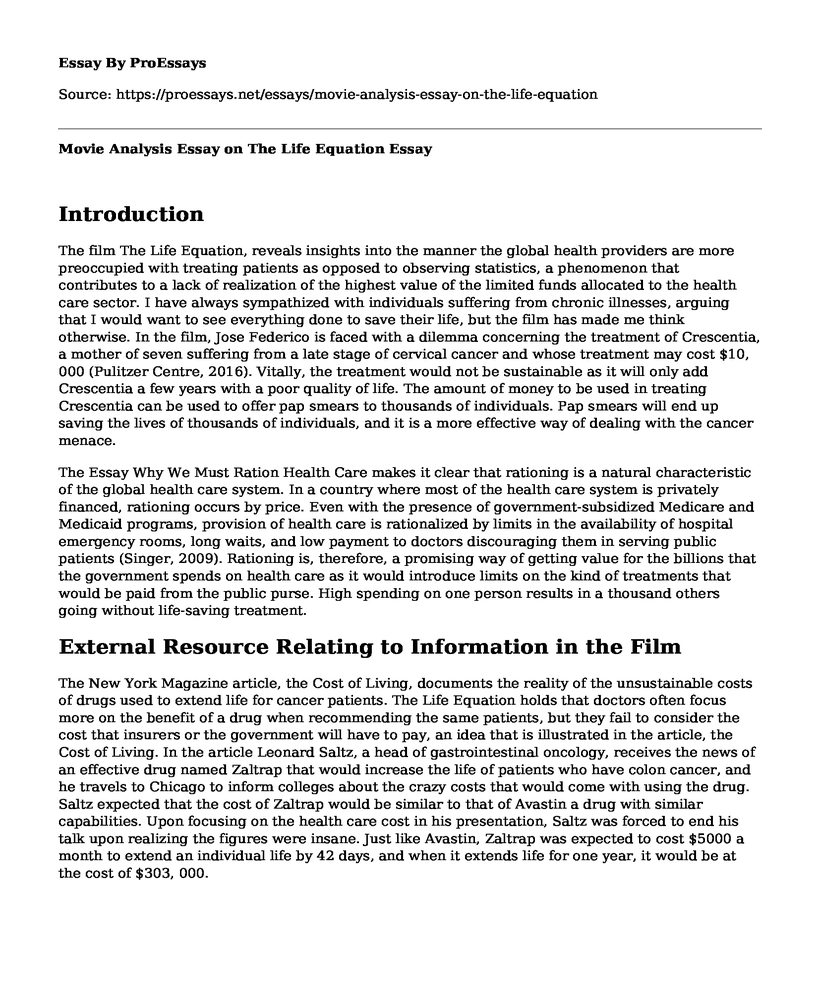Introduction
The film The Life Equation, reveals insights into the manner the global health providers are more preoccupied with treating patients as opposed to observing statistics, a phenomenon that contributes to a lack of realization of the highest value of the limited funds allocated to the health care sector. I have always sympathized with individuals suffering from chronic illnesses, arguing that I would want to see everything done to save their life, but the film has made me think otherwise. In the film, Jose Federico is faced with a dilemma concerning the treatment of Crescentia, a mother of seven suffering from a late stage of cervical cancer and whose treatment may cost $10, 000 (Pulitzer Centre, 2016). Vitally, the treatment would not be sustainable as it will only add Crescentia a few years with a poor quality of life. The amount of money to be used in treating Crescentia can be used to offer pap smears to thousands of individuals. Pap smears will end up saving the lives of thousands of individuals, and it is a more effective way of dealing with the cancer menace.
The Essay Why We Must Ration Health Care makes it clear that rationing is a natural characteristic of the global health care system. In a country where most of the health care system is privately financed, rationing occurs by price. Even with the presence of government-subsidized Medicare and Medicaid programs, provision of health care is rationalized by limits in the availability of hospital emergency rooms, long waits, and low payment to doctors discouraging them in serving public patients (Singer, 2009). Rationing is, therefore, a promising way of getting value for the billions that the government spends on health care as it would introduce limits on the kind of treatments that would be paid from the public purse. High spending on one person results in a thousand others going without life-saving treatment.
External Resource Relating to Information in the Film
The New York Magazine article, the Cost of Living, documents the reality of the unsustainable costs of drugs used to extend life for cancer patients. The Life Equation holds that doctors often focus more on the benefit of a drug when recommending the same patients, but they fail to consider the cost that insurers or the government will have to pay, an idea that is illustrated in the article, the Cost of Living. In the article Leonard Saltz, a head of gastrointestinal oncology, receives the news of an effective drug named Zaltrap that would increase the life of patients who have colon cancer, and he travels to Chicago to inform colleges about the crazy costs that would come with using the drug. Saltz expected that the cost of Zaltrap would be similar to that of Avastin a drug with similar capabilities. Upon focusing on the health care cost in his presentation, Saltz was forced to end his talk upon realizing the figures were insane. Just like Avastin, Zaltrap was expected to cost $5000 a month to extend an individual life by 42 days, and when it extends life for one year, it would be at the cost of $303, 000.
Critique of the Film
The film, the Life Equation has been instrumental in revealing that health rationing in the case where the cost of medication is very high should not be considered immoral. Jose Federico, the health care worker, wants to connect the impoverished Guatemalans with the health care they need. The Dilemma that results from coming across, Crecencia, the patient with the last stage of cervical cancer makes him realize the importance of using Unitarianism ethics in health care. Letting one person die whose cost of care would be too high is beneficial in saving money that can be used in saving the lives of many other people. One of the shortcomings of the film is the recommended way of determining the most effective interventions (Pultizer Centre, 2016). Allowing computers to make decisions on interventions to deliver to patients based on value for money would not take into account the complexities that occur in real life. For instance, some individuals and their families are incredibly wealthy, and they can afford treatment of the highest cost. Failure to involve the voices of patients and their families when deciding on treatment methods using bad data can result in significant ethical issues.
Question
Should the Food and Drugs administration analyze the cost of drugs that are about to be realized into the market and where the drugs are very costly, consider withholding approval. The Food and Drugs administration only considers the safety and effectiveness of new cancer drugs before they are released to the market. However, drugs costing like $10 000 a month, not including other costs including hospitalization, end up being too costly for individuals and even insurers, and still, the patient cannot recover fully since many only extend life by days or months.
References
Hall, S. (October 18, 2013). The cost of living. New York Magazine. http://nymag.com/news/features/cancer-drugs-2013-10/
Pulitzer Centre. (2016). The life equation.
Singer, P. (2009). Why we must ration health care. P. 1-5.
Cite this page
Movie Analysis Essay on The Life Equation. (2023, Mar 29). Retrieved from https://proessays.net/essays/movie-analysis-essay-on-the-life-equation
If you are the original author of this essay and no longer wish to have it published on the ProEssays website, please click below to request its removal:
- The Novelty of Documentary Movies Speech Example
- Targets (1968) Film Essay Example
- Classmates React to Images of Different Cultures: Impact on Graphic Design - Essay Sample
- History of Photography Essay
- Essay Sample on Digital Diplomacy: How Twitter is Changing the Global Landscape
- Film Analysis Essay on Do the Right Thing: Condemning Violence and Police Brutality
- Free Essay on Interpersonal Communication in Age of Social Media: Impacts on Users







